
at the Sign of the Hygra
2 Middleton Road
London E8 4BL
Tel: 00 44 (0)20 7254 7074
email: boxes@hygra.com
Antique Boxes in English Society
1760 -1900
by ANTIGONE
WRITING BOXES
 |
ANTIQUE BOXES at the Sign of the Hygra 2 Middleton Road London E8 4BL Tel: 00 44 (0)20 7254 7074 email: boxes@hygra.com |
Antique Boxes in English Society |
| BEFORE 1780 | ||
| FROM 1780-1800................................................................. | WRITING BOXES WRITING SLOPES |
|
| FROM 1800-1830................................................................. | WRITING BOXES WRITING SLOPES |
|
| FROM 1830-1900................................................................. | WRITING BOXES WRITING SLOPES |
Whereas the Tea Caddy and the Sewing Box can be said to be accurate reflections of the stylistic and cultural influences of the 18th and 19th centuries, the Writing Box epitomises the social and economic developments of this particular period. Portable boxes for writing materials had existed for many centuries and in many cultures. However it was not until the last decades of the 18th century that the socio-economic circumstances in England necessitated the wide use of a portable desk in the form of a box which could be used on a table or on one's lap. Hence "Lap Desk". Although quality, ornament and form did play an important part in its selection as a personal item, it is the purpose for which it was used which gave prominence to the writing box, at a time of expanding intellectual curiosity, communication, literacy and increased commercial activity. The writing box was an item of style and fashion yes, but it was also an item connected with intelligence, commerce and world awareness. |
"a lady's traveling box" from Thomas Sheraton |
From the end of the 18th, to the end of the 19th century, the writing box featured prominently on military expeditions, travels, libraries and in drawing rooms. Great literature as well as dispatches, contracts, letters and postcards were written on its sloping surface. Through it both business and personal activity were transacted. Unlike the writing desk or table it was a personal and not a household possession.
The stylistic development of the writing box in the first part of the 18th century can be traced to portable inkstands, writing sets, oak bible boxes and sloping bible/writing boxes.
The few which were made before 1780 were rectangular and had sloping tops, less steep than the earlier bible boxes. They had side drawers for paper and spaces for containers of ink and sand. Dr Johnson tells us that Alexander Pope (1688-1744) "actually required that his writing box should be set upon his bed before he rose"
WRITING BOXES and SLOPES 1780-1800
However by the last decades of the century writing boxes were necessary in many non-domestic situations and the tops became flat in order to facilitate transportation.
The increased popularity of the writing box by the end of the century can be attributed to two main reasons. The onset of the Napoleonic wars and the popularity of travelling. Officers in the army had their own boxes, using them both for army business and for writing home.
Travelling then was altogether a more complex business than it is now.
By the end of the 18th century, apathy and stagnation of thought had caused the education system in England to disintegrate. Schools and universities were establishments of rites of passage for the ruling classes who had hitherto held the wealth and privilege of the land.
At the same time exciting things were happening abroad. News of excavations in Europe and North Africa stimulated the imagination. Books on different subjects became more widely available. Scientific and medical thinking was given a new impetus through alternative educational establishments set up by the progressive thinkers of the time.
Well to do young men found a way of accumulating knowledge by going on the 'grand tour' of Europe. Some came back wiser, some just had a good time. Architects, artists, thinkers took to travelling more seriously and brought back impressions, drawings, objects and sculptures. Their knowledge was disseminated through publications and through professional application.
Men with entrepreneurial leanings went off to India, China and wherever there were trading opportunities, travelling on English ships which were establishing their supremacy on the oceans. The mobility of a substantial section of the population became part of the social ethos.
Both the travelling civilians and the army officers needed compact and strong writing boxes, which could withstand the rough and tumble of strenuous journeys. This gave rise to the most popular type of 18th century writing box, the military style, or campaign box. In look this is similar to the military chest.
These are typical characteristics of writing boxes of the period:
The solid mahogany brass bound writing boxes look good even when battered by usage. Restoration, which destroys their patination and gives them a later glossy look, is inappropriate and detrimental to their character.
Such boxes continued to be made and used well into the 19th century. Oliver Goldsmith in the 18th century, Charles Dickens and Lord Byron later, are some of the intellectuals who possessed sturdy writing boxes.
EXCEPTIONAL WRITING BOXES
These are stylistically the same as the writing boxes described above, but they are made to perform an extra service for their owner.
1. One type of such writing box incorporates personal grooming items such as a gentleman would require on his travels, i.e. shaving and general hygiene containers.
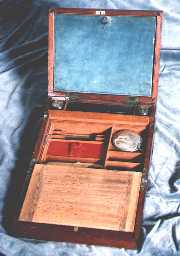 |
A combined writing box and dressing box of c1800. The top writing flap opens down to give access to grooming/shaving accessories. The lower flap has the conventional space for storing paper. The box is typical of the period made with solid mahogany reinforced with brass bindings. The brass binding protects the box from warping in changes of humidity. It also provides structural reinforcement for something expected to have a hard and useful life. |
2. Another type incorporates a machine for printing. This comprises a heavy brass cylinder, which is turned by a handle over a sliding surface, enabling the fast copying of maps, dispatches etc.
3. Ship Captain's Writing Box. Mechanically the most complex and intriguing of all such boxes. Each one seems to differ in its arrangement of secret compartments and drawers. Often there are spaces for candlesticks and a reading stand. Their most unique feature is that they have a mechanism enabling them to be screwed down, thus achieving some stability in stormy seas.
4. Triple opening writing boxes. These were made to open in two directions, one part upwards, the other down. The middle and down part form the two sections of the normal writing box. The upper part opens as an upright lid with an attached leather covered container and sometimes 'pockets' for notes etc. Most impressive even when opened to writing position.
These four types of writing box are now rare.
WRITING SLOPES LATE 18th CENTURY.
These are not as usual as the rectangular boxes, but the ones, which have survived to our day, bear witness of fine artistic judgement and craftsman-ship. They were made for gentler more personal use and as such they are more varied in style than the 'military' writing boxes.
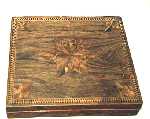 |
A Brazilian Rosewood writing slope of c 1790 inlaid with exotic and native woods in a geometric star pattern. It opens to reveal a writing surface pen tray and place for keeping paper. |
The postal service was pretty inefficient and chaotic up to about 1784, when armed guards were introduced on mail coaches rendering them safe, fast and efficient for the first time. Delivery of letters was much improved and so was the art of letter writing, which became a genteel occupation in its own right. Fine boxes, which could easily be carried from room to room and fit comfortably within the interiors of fine drawing rooms and libraries, were made to serve the need of private correspondence.
These boxes are smaller and of a more delicate style than the solid mahogany brass bound type. They are a development of the early sloping bible box shape, only the slope is more gentle, the box shallower and the construction much lighter. The front cover of the box opens back to reveal a sloping surface for writing. This consists of a flap, under which there is a space for paper. At the back there is a section for inkwells and pens.
Most of these smaller boxes were made of pine, occasionally of mahogany or oak and veneered in carefully selected saw cut thick veneers of beautifully figured woods. Fruitwoods, yew, mahogany, satinwood and others were combined together in simple or complex decorative pat-terns. They were often decorated with stringing, cross banding and marquetry of the finest quality.
Some of the most exquisite boxes date from this period. There are examples veneered in beautifully figured native woods such as yew as well is those veneered with exotic imported timbers. There were boxes incorporating Tunbridge Ware with marquetry. There were also boxes decorated with Penwork, Chinoiserie and Painted scenes. Often these were varnished in order to protect the pigments and inks.
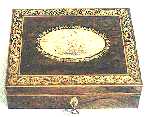 |
A rosewood writing slope of c 1790. The rosewood is framed with sycamore with penwork decoration of stylised foliage. The centre panel has a hand tinted print of classical inspiration framed in gold leaf and pen and ink decoration. |
Small sloping boxes of the 18th century have the charm and period flavour of their era and are now very rare.
Very occasionally there are boxes of this type, which combine sewing and writing elements; for example a box may have a shallow drawer containing sewing tools.
ANGLO INDIAN
Very fine examples of Anglo Indian boxes date from this period. Sometimes combined with sewing boxes. These too are very rare.
WRITING BOXES AND SLOPES 1800 to
1830
WRITING BOXES
WRITING SLOPES
This is loosely known as the Regency period although George IV was Prince Regent only for the second decade of the 19th century. On the death of George the III in 1820 he became king until his own death in 1830. However the term Regency typifies a stylistic tendency typical of the beginning of the century and much encouraged by George the IV himself.
Mahogany boxes with flat tops continued to be made with very slight modifications. The handles tended to be set in and the escutcheons and top plates were often made in more complex shapes.
It is difficult to generalise as styles overlapped and older features continued to be in use. Customer preferences were considered but although the rules were not rigid we can detect distinguishable trends.
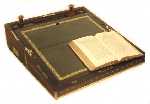 ENLARGE ENLARGE |
Instead of solid mahogany throughout, the boxes were made in plain mahogany for strength and stability and then veneered in figured mahogany, rosewood or kingwood. The veneers were carefully selected for their rich appearance. The surfaces were French polished which enhanced the beauty of the dark striations within such woods as kingwood and rosewood and the beautiful figure of mahogany and other woods. |
By the second decade of the 19th century the strengthening devices such as brass bindings, now often in the form of brass edgings, were enhanced with decorative features. Extra stringing, circles, fleur-de-lis, intricate escutcheons, ornamental top plates.
Instead of solid mahogany throughout, the boxes were made in plain mahogany for strength and stability and then veneered in figured mahogany, rosewood or kingwood. The veneers were carefully selected for their rich appearance. The surfaces were French polished which enhanced the beauty of the dark striations within such woods as kingwood and rosewood and the beautiful figure of mahogany and other woods.
The writing surfaces were covered in velvet or leather and the interior was sometimes polished. The secret drawers were by this time more popular than the side drawer. Occasionally both were used, especially on larger boxes.

|
Some details of a captains box of about 1800. The picture on the right shows a screw which is inserted in the hole and turned with the key which is kept in the slot when not in use. This enables the box to be secured in stormy seas. This boxes often have individual and complex interiors. The picture on the left shows a pull out box under which there are further secret compartments | 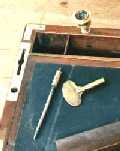 ENLARGE |
Triple and Captain's boxes from this period are very rare.
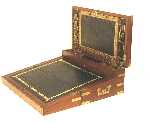 |
A double opening or triple writing box of c1810 made in the traditional campaign style of solid mahogany with brass straps corners and countersunk handles. The upper part has pockets in gold embossed leather and a central section which folds down to reveal a pocket for letters. ENLARGE PICTURE |
The first boxes to depart from the military look still retained their robust qualities. Gradually however the military features such as handles and thick brass edgings and corners gave way to more ornamental rather than strengthening use of brass. Dark rosewood or figured mahogany boxes were made with subtle brass stringing enhanced with circular small ornaments or curvilinear escutcheons.
 ENLARGE |
An example of secret drawers in a good quality writing box of c 1815. A panel is released when finger pressure is applied to part of the box, in this example the inkwell has to be taken out to access. |
Other boxes were more ambitiously ornamented in the manner promoted by Thomas Hope with borders of floral swags. Occasionally a box was completely covered with inlays of leaves, flowers and even grotesques in flowing combinations.
Dark woods and bright brass are certainly mutually enhancing and these high Regency boxes have an excellent 'period' look.
 ENLARGE ENLARGE |
Writing box veneered in very
thick strongly figured Brazilian rosewood. Banded and inlaid in brass. Brass
set-in handles on the side. It opens down to reveal a writing surface and
space for writing implements. Under the last space there are also secret
drawers which are revealed by a spring mechanism.
English circa 1815 |
Another decorative device, which was beginning to be used from about the second decade of the 19th century, was inlay in mother of pearl. This was very fine and usually consisted of stylised floral designs. Birds and the occasional animal, such as deer were sometimes incorporated within the design. White metal lines were used if stringing was required.
Simpler boxes of rosewood with mother of pearl circles and metal stringing were beginning to appear by the 1820s. This style continued to be made for a few decades, the veneers becoming thinner as the century progressed.
During the early part of the 19th century, vandyke and cube Tunbridge Ware, mahogany, yew, or fruitwood boxes with marquetry, stringing, crossbanding, or in combinations of woods were also made. These boxes are often unique, idiosyncratic and delightful with a character all of their own and very sought after by serious collectors.
Characteristics of early 19th century writing boxes:
1. Thick veneers of mahogany, kingwood, rosewood, occasionally yew or fruitwoods on mahogany base.2. Brass inlay, fine lines or floral swags.
3. Fine mother of pearl inlay.
4. Marquetry of naturalistic, neo classical or geometric designs.
The sloping writing boxes dating from this period changed very little in style from the late 18th century, although their arrangement was subtly modified so as to give more room for writing. The introduction of a narrow flap at the back part of the top which opened to reveal the pen and inkwell section, enabled the main flap to open downwards giving a larger writing surface.
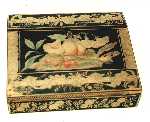 |
A writing slope of c1810 decorated with a floral border in penwork and a central painted picture of flowers and fruit. The introduction of a narrow flap at the back part of the top which opened to reveal the pen and inkwell section was in the late 18th century. |
As in the writing boxes, inlaid brass, mother of pearl and marquetry were used for decoration. In addition very fine examples of Chinoiserie, Penwork and Tunbridge Ware slopes date from this period, although these are now few and far between.
Another kind of writing slope, which made its appearance in England at about this time, was in the Boulle style, in tortoiseshell and brass. These were mostly imported from France. The shapes of these slopes are elaborate versions of the wooden slopes. The back part is higher and often curved. The interiors are of polished rosewood, or ebonised wood. The flaps are velvet covered.
Papier Mâchè slopes had only one flap opening downwards allowing for the continuity and integrity of their fine decoration. Few rare and very beautiful Anglo Indian boxes in both shapes date from this period.
WRITING BOXES AND SLOPES 1830 to 1900
WRITING BOXES 1830-1900
WRITING SLOPES 1830-1900
The transformation of English society, which had started in the middle of the 18th century, culminated by the fourth decade of the 19th century in a social structure which would have been unrecognisable 100 years earlier. Basically what had been a mainly agricultural society had been transformed by land reforms, mechanical inventions and expanding overseas trade into an industrial society with brisk trading and modified agricultural activity.
The greatly expanding population gravitated towards the towns with the result of many active commercial centres being established outside London. The necessity for goods to be transported gave great impetus to improved transport, which in turn facilitated a great boom in personal travel.
Education was revived in many levels of society to cope with the new needs. Steam driven presses (first used in 1814) had lowered the cost of printing, with the result that books, periodicals, magazines etc. became more plentiful and mobility of ideas more possible.
The steel pen nib, which was first patented by Gillott in 1831, made the use of quills or rigid metal pens unnecessary. Writing became simpler. The Penny Post in 1840 enabled the sender to pay for letters and as a result letters quadrupled in the following decade. They were followed by postcards, Christmas cards, Greeting cards and Valentines.
Easily portable writing boxes became obligatory for more people as more people transacted business, travelled or wrote letters from home.
During the 1830s and 1840s craftsmen making writing boxes continued to develop the inlay possibilities of the earlier decades. Mother of pearl and thinner brass superseded heavier brass decoration. Boxes veneered in a combination of rosewood and bird's eye maple creating floral inlay borders were also made, but marquetry in the neo classical style was no longer fashionable.
 |
Detail of a remarkable mother of pearl inlay in the top of a mid 19th century writing box veneered in coromandel. This box was made by LUND who were one of the most important firms in the middle of the 19th century. |
A new decorative style appeared by this time. Examples of these boxes, bearing the label of LUND, a firm renowned for quality, are known to exist. Fine brass lines, mother of pearl and abalone shell were inlaid on coromandel or rosewood veneered boxes to form designs of flowers, birds, animals and even humans. Very few of these were made as both the materials and the work must have been very expensive.
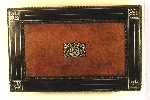
|
An exceptional example of a writing box of the second quarter of the 19th century. The main panel is in a highly figured burr wood, and surrounded in a raised frame edged in gadrooning and inlaid with white metal and mother of pearl. | 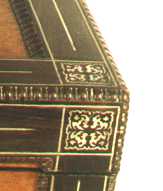 |
By the middle of the century by far the most popular style was an adaptation of the earlier military type of box. Less solid and lighter both in style and construction the characteristics of these later brass bound boxes are:
1. Basic box in mahogany or later in pine.2. Veneered in thin knife cut veneer, which was cut by mechanised processes, in walnut, bird's eye maple, burr chestnut, or rosewood. In more expensive boxes the veneer was still quite thick, usually coromandel, rosewood or figured mahogany.
3. The brass bindings were either in the form of now rounded brass surround, or brass corners and straps. The brass was glued and secured by small brass studs.
4. The outside and inside wood was French polished and glossy.
5. The flaps were mostly covered in leather, but velvet was still used.
6. Secret drawers invariably superseded the side drawer, although sometimes both were still used.
By the later part of the century the basic box was sometimes made of pine and veneered with very thin veneers. The brass became very thin or replaced with geometric inlays, which were produced using mechanical processes. These boxes are still very attractive but much lighter than their predecessors are.
 |
A good example of a mid century writing box veneered in well figured walnut and edged in brass. The interior has the characteristic two flaps and secret drawers. |
Two earlier types of writing slopes, which continued to be made during this period, were decorated in a different style to those of the earlier decades.
Tunbridge Ware inlays on writing slopes were now of the mosaic pictorial type. Papier Mâchè decoration invariably incorporated mother of pearl and abalone shell.
Wooden slopes in the earlier decorative styles disappeared but a new style developed out of the Gothic Revival. These were sloping boxes very much in the shape of the earlier ones. They were well made in mahogany, veneered in thick coromandel or burr walnut. They were decorated with overlays of perforated or engraved brass and sometimes with jasper medallions. Occasionally they formed part of a desk set with the back part higher and more rounded, or even in the form of a domed envelope/card box. These epitomise the ostentatious taste of the Victorian entrepreneur. They combine impeccable workmanship with glamour.
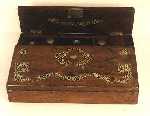 |
A rosewood writing slope of c1835 with fine mother of pearl inlay. The upper flap covers compartments for pens and inkwells. |
Simpler burr walnut or coromandel slopes were also made. These relied for their appeal on the beauty of the grain of the wood or fine brass/mother of pearl decoration. The surviving examples are of very high quality.
© 1999 Antigone Clarke and Joseph O'Kelly